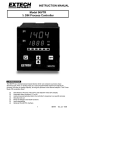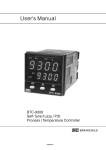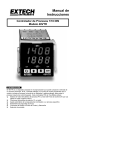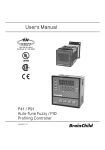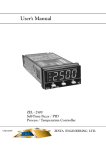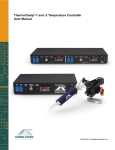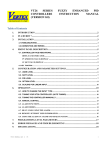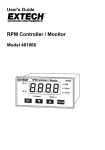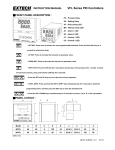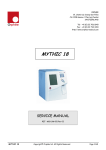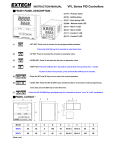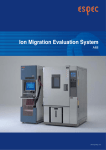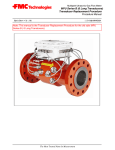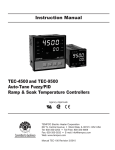Download Instruction Manual - Extech Instruments
Transcript
Instruction Manual English / Español Model 48VTR 1/16 DIN Process Controller 1. INTRODUCTION The 48VTR is a microprocessor-based device which can compare a process input (thermocouple, RTD, or analog input) to a user-programmable setpoint and adjust the process (via relay or analog output), to bring the process to the desired setpoint. This ThreeMode PID controller offers: Simultaneous Process Value (PV) and Setpoint Value (SV) display Automatic alarm functions (11 in all) Auto-Tuning automatically tailors the controller's response to a specific process Security lock-out Ramp-to-Setpoint and Soak functions Input selectability 2. SPECIFICATIONS 2.1 General Specifications Display Status Indicators LED display span Indicating Accuracy Sampling Time Memory Meter Enclosure Front Panel Power Supply Power Consumption Insulation Resistance Noise Rejection Operating Temperature / Humidity Storage Temperature Dimensions (Cutout) Dual 7-segment 4-digit LED Displays: Red (PV), Green (SV) For Control output, Alarm output, Over range, AutoTune, and Open Input -1999 to 9999 counts max (Programmable) +0.2% Full Scale +1 digit 1 reading per 0.25 seconds Nonvolatile type ABS Plastic Lexan (Drip and Dust Proof; IEC IP55, NEMA Equivalent) 85 to 260VAC 50/60 Hz (automatic switching) 6 Watts >50MΩ Common Mode: 110 db typical; Normal Mode: 50 db typical o o 14 to 122 F (-10 to 50 C); 90% RH max. o o -4 to 140 F (-20 to 60 C) 1.77 x 1.77" ±0.02" (45.0 x 45.0mm ±0.5mm) 2.2 Input Specifications Thermocouple input (Programmable) RTD input Current input Voltage input Thermocouple Ranges Type K Type J Type B Type T Type E Type R Type S Type N RTD PT100 input ranges Linear input range Temperature Stability Repeatability 48VTR English 9/00 Types: J, K, T, E, B, R, S, N; Cold Junction Compensation Thermocouple Break Protection: Upscale and Downscale Lead Wire Effect: 0.015%/ohm (Input impedance: 10 megohm) Pt 100 ohm (DIN, JIS); RTD Break Protection: Upscale and Downscale Lead Wire Effect: 0.015/ohm (automatically compensates if one lead wire is < 5 Ω) 4-20mA DC (2.7Ω input impedance) 1-5V DC o o -58 to 2498 F (-50 to 1370 C) o o -58 to 1830 F (-50 to 1000 C) o o 32 to 3272 F (0 to 1800 C) o o -454 to 752 F (-270 to 400 C) o o -58 to 1382 F (-50 to 750 C) o o 32 to 3182 F (0 to 1750 C) o o 32 to 3182 F (0 to 1750 C) o o -58 to 2372 F (-50 to 1300 C) o o -392 to 932 F (-200 to 500 C); (DIN or JIS) -1999 to 9999 display span (for 4-20mA, 1-5V, or special DC input). o 5uV/ C typical o o 0.83 C (Thermocouple); 0.2 C (RTD); 1 digit (Linear) Ver. 2.7 1 2.3 Output Specifications Control Output Relay 5 Amps @ 110V AC; SPDT (Resistive Load) Control Output DC Voltage (Pulsed) 24V DC (DC drive for SSR) ON: 24V DC typical, 29V DC max. OFF: 0.3V DC max Analog Control Output (Current) 4-20mA DC; Load limit: 600Ω max. Alarm/Timer Types High/Low Deviation/Absolute Alarms w/deadband adjust plus Soak/Event Timers Alarm Output Relay 3 Amps @ 110VAC; SPST (Resistive Load) Output Control Modes Proportional Band 0.0 to 100.0% of Full Scale (can be Auto Tuned) Integral Time 0 to 3000 secs. (can be Auto Tuned) Derivative Time 0 to 3000 secs. (can be Auto Tuned) Cycle Time 1 to 100 secs. (0 sec for 4-20mA output) Anti-Reset Wind-Up Inhibits integral action outside of the Prop. Band Manual Reset 0 to 100% of Prop. Band Hysteresis 0.0 to 25.5% of Full Scale 3. MOUNTING AND WIRING 3.1 3.2 3.3 3.4 3.5 3.6 Prepare a 1.77x1.77" ±0.02" (45x45mm ± 0.5mm) panel cutout The panel on which the controller will be mounted may be up to 0.4" (10mm) thick. Remove the plastic mounting bracket. Slide meter into panel through the cutout. Replace the mounting bracket and then tighten the bracket screws. Do not tighten the mounting screws excessively. Connect the power cord to the meter but do not connect to power source (refer to wiring diagram below). Connect sensor input and control/alarm outputs (Fig.3) Connect power to source. Wiring Notes AC Power: The AC supply terminals can handle 85 to 260VAC 50/60Hz without having to be physically switched or specially configured. Control relay: Terminals 8-9 are Normally Open (NO) and Terminals 8-10 are Normally Closed (NC) when the controller is powered down or when the controller is powered on and the relay is not active. Relays themselves DO NOT supply AC power. AC Power must be wired to Relay terminals. Alarm relay: Terminals 4-5 are Normally Open (NO) when controller is powered down AND when it's powered-up in a non-alarm condition. Relays themselves DO NOT supply AC power. AC Power must be wired to Relay terminals. Inputs: Terminal 1 is negative and terminal 2 is positive for TC and Analog inputs. 3wire RTD use terminals 1-2-3 as shown. 2-wire and 4-wire RTD can also be used, refer to Figure 3. 48VTR English 9/00 Ver. 2.7 2 Warning: An independent redundant alarm should be used if control/alarm relay failure could result in potential harm or damage. Control Output AC 2-wire RTD 4-20 6 7 8+ 9- 1 + 2 3 4 1 10 5 2 3 4-wire RTD 1 2 3 Short terminals 1 and 2 TC Leave the 4th wire open Analog Alarm Output RTD Figure 3 4. METER DESCRIPTION 1. Process Variable (PV) Display 2. Setpoint Variable (SV) Display 3. Control Output Status LED 4. Alarm Status LED 5. 'Return' Programming Key 6. Down Arrow Programming Key 7. Up Arrow Programming Key 8. 'Scroll' Programming Key 9. Auto Tune Decimal Indication 10. Mounting Bracket 11. Bracket Screw 5. FRONT PANEL DESCRIPTION 5.1 PV (Process Variable) Display LEDs During normal operation, the top LED (red digits) displays the actual process measurement (temperature, voltage, or current input signal). This process measurement is known as the "Process Variable" or PV. In programming mode, these red LEDs display the parameters from Programming Levels 1 through 4 (input type, control action, etc.), one at a time. These parameters can be edited to suit the user's requirements. Error messages are also displayed on these red LED Digits. Programming details and error messages are explained later in this manual. 5.2 SV (Setpoint Variable) Display LEDs During normal operation, the bottom LED (green) displays the user-programmable Setpoint Variable (SV). This represents the desired process equilibrium point to which the controller's output will adjust the process. To adjust the setpoint, use the up/down arrow keys. The allowable setting range equals the range the user selects in LoLt (Low Limit) and HiLt (High Limit) parameters during programming. While programming, this green LED display shows the actual data that can be edited for the parameter shown on the red LED display. For example if the red LED is displaying input type, then the green LED lists the input types (J, K, Linear, etc.). The user can then select the desired type using the programming keys. Refer to later sections for more on programming. 48VTR English 9/00 Ver. 2.7 3 5.3 Status Indicators 'ALM' Status Indicator (Alarm Relay Status LED) This LED is lit in red when the Alarm relay is active. Also, this LED flashes when the Alarm is configured as an Event/Soak timer and is in the process of counting down. Refer to Appendix A for more on Alarm Functions. 'OUT' Status Indicator (Control Output Status LED) Illuminates in green when the control output is active. AUTO TUNE Status Indicator When the controller is auto tuning, the rightmost decimal on the green LED display will blink on/off. When the meter is finished tuning, the decimal will cease blinking and disappear. Auto Tuning may take from several minutes to several hours depending upon the process in question. See section 9.2 for details on Auto Tune. LED Error Messages: Err 1: A/D converter is inoperable. Unit must be repaired or replaced. uuuu: Over range condition with regard to input signal. nnnn: Under range condition with regard to input signal. - - - - : Input sensor not connected or is inoperable. 5.4 Keypad Descriptions SCROLL Key Press once to access the programming mode’s first level. In programming mode, move from one programmable parameter to the next by pressing the SCROLL key. The SCROLL key is also used in combination with the RETURN key to move between programming levels. The red LED display will show each parameter title as you scroll through the list. Also, to activate an autotuning session, press and hold the SCROLL key for 5 seconds. UP Arrow Key Increases the Setpoint (SV). Also increments parameter data when programming. DOWN Arrow Key Decreases the Setpoint (SV). Also decrements parameter data when programming. RETURN KEY During normal operation, pressing the RETURN key permits the user to view the controller output action as a percentage (0.0-100.0%). Press this key from any other mode to return to the normal SV display. The RETURN key is also used with the SCROLL key (pressed simultaneously) to move from one programming level to another. 48VTR English 9/00 Ver. 2.7 4 Table I - Programming Level Parameters (default values) at a glance 1st Prog. Level 2nd Prog. Level RAmp (0.0) Pb (0) oPoF (0.0) Ti (240) A1SP or timE Td (40) Note: Symbols shown are similar to the actual LED meter displays, which show parameters in mixed case. Some parameters may not appear depending upon the setting in P-L (Parameter Lock) in 3rd programming level * Default value is dependent on the type of input or output installed in the device. 3rd Prog. Level REmo (0) P-L (4) A1FU (2) A1HY (0.1) Act (1) Unit (*) Dp (*) Ct (15) HYST (0.1) EroP (2) Addr (0) PvoF (0.0) TYPe (*) LoLt (0.0) HiLt (500.0) 4th Prog. Level LoCA (0.0) HiCA 1000 TunE (1) 6. FIRST PROGRAMMING LEVEL PARAMETERS Press the SCROLL key to enter this level. Then use the SCROLL key to move through the parameter list. Use the ARROW keys to change the setting. To return to normal operation at any time, press the RETURN key once. Note: The configuration of the controller will dictate which parameters will appear. For example, the 'ramp' parameter will not appear if Parameter Lock is set to a value of '2' or ‘0’. Also, A1SP will not appear in the parameter list if parameter A1FU (alarm function) is set to a value of 8,9,10, or 11. rAmp: Programmable rate of rise limit for PV. Permits the user to restrict the rate at which the measured variable (PV) changes. Setting range: 0.0 to 100.0 units per minute. Default = 0. The controller will monitor the changing PV and override the controller output if necessary to limit the PV's rate of change. oPoF: Output Offset. "Manual reset" function. The user can program a value (0.0 to 100.0%) which will then be added to the controller output percentage. For example, if the oPoF parameter is set to 10.0%, the controller's output percentage will always be 10% higher. A1SP: Alarm Setpoint value. (Set the desired Alarm type in the A1Fu parameter, refer to Appendix A for Alarm functions). Allowable setting range is limited by parameter 'LoLt' and 'HiLt' (Low and High Limit) settings and the input type selected. To lock out A1SP press the SCROLL and DOWN keys together for 4 seconds. Use same key-press to unlock A1SP. timE: Programmable duration for the Event/Soak Alarm Output Timers. The range is 0 to 9999 minutes. Refer to Section 13 and Appendix A for details on Soak/Event Timer functions. 7. SECOND PROGRAMMING LEVEL PARAMETERS Press and hold the SCROLL and RETURN keys simultaneously to enter this level from the previous programming level. To return to normal operation at any time, press the RETURN key. NOTE: This is the Manual Tuning programming level. Rather than attempting a manual tuning it is strongly recommended that AUTO TUNING be used to automatically set these parameters. If PID Tuning is unfamiliar to you, manual tuning can cause severe process disturbances. Try Auto Tuning first and then use Manual tuning afterward to fine tune the parameters if desired. For the instructions on how to initiate an Auto Tune session, refer to Sec. 11 48VTR English 9/00 Ver. 2.7 5 Pb: Proportional band value. Setting range from 0.0 to 100.0% of controller's Span. Default = 10.0. Set Pb to 0.0% for ON/OFF control action. This value is automatically calculated by activating the AUTO TUNE function. If desired, the user can later adjust this parameter to better suit the application. ti: Integral (Reset) value. 0 to 3000 seconds setting range. Default = 240. This value is automatically calculated by activating the AUTO TUNE function. If desired, the user can later adjust this parameter to better suit the application. td: Derivative (Rate) Time. 0 to 3000 seconds setting range. Default = 40. This value is automatically calculated by activating the AUTO TUNE function. If desired, the user can later adjust this parameter to better suit the application. 8. THIRD PROGRAMMING LEVEL PARAMETERS Press and hold the SCROLL and RETURN keys simultaneously for 5 seconds to enter this level from the second programming level. To return to normal operation at any time, press the RETURN key. rEmo: Unused (must be set to ‘0’) P-L: Parameter Lock. This security feature locks out selected programming levels or single parameters prohibiting tampering and inadvertent programming changes. Depending upon setting, only certain Level 1 parameters display. Setting 0 1 2 3 4 5 6 7 8 9 10 11 12 13 14 15 Parameter Lock-out effect All parameters adjustable (Level 1 parameters: A1SP only) Same as ‘0’ (level 1 parameters: Ramp and A1SP) Same as ‘0’ (level 1 parameters: oPoF and A1SP) Same as ‘0’ (level 1 parameters: Ramp, oPoF, and A1SP) Same as '0', but level 4 is locked out Same as '1', but level 4 is locked out Same as '2', but level 4 is locked out Same as '3', but level 4 is locked out Same as '0', but levels 3 and 4 are locked out Same as '1', but levels 3 and 4 are locked out Same as '2', but levels 3 and 4 are locked out Same as '3', but levels 3 and 4 are locked out Same as '0', but levels 2, 3, and 4 are locked out Same as '1', but levels 2, 3, and 4 are locked out Same as '2', but levels 2, 3, and 4 are locked out Same as '3', but levels 2, 3, and 4 are locked out A1Fu: Alarm Function. Select the desired Alarm or Timer function from the alarm functions list in Appendix A. A1HY: Hysteresis for Alarm. The Setting range is 0.0 to 25.5% of the controller's span settings. The controller's Span extends from the value programmed in 'LoLt' to the value programmed in the 'HiLt' parameter (Low and High Limits). Hysteresis is used to eliminate relay "chatter" by creating a deadband that extends from the alarm setpoint down or up (depending upon the alarm type) where no relay action can occur. The larger the hysteresis value the less the possibility of relay chatter. Act: Output control action. Set to "0" for cooling (direct) action or "1" for heating (reverse) action. unit: Unit of measure selection. Program as follows: degrees F degrees C Process inputs 0 1 2 48VTR English 9/00 Ver. 2.7 6 dP: Decimal Point selection. no decimal point 0.1 resolution 0.01 resolution (cannot use this setting for temperature inputs) 0.001 resolution (cannot use this setting for temperature inputs) 00 01 02 03 Ct: Control Output Cycle Time. Range: 0 to 100 seconds. This is the period of time the controller waits between output percentage changes. The longer the time set here, the less responsive the controller will be to process changes. Set Ct for the longest period of time possible without causing process oscillations; this will help to prolong the life of the relay. NOTE: Set ‘Ct’ to '0' seconds for the 4-20mA analog output option. Parameter 'Ct' is not used when ON/OFF control is activated. Hyst: Hysteresis for ON/OFF control output. Users can create a deadband region from 0.0 to 25.5% of SPAN. The SPAN is the region that extends from the user-programmable Low Limit (LoLt) value to the High limit (HiLt) value. Hysteresis is used to eliminate control relay chatter by creating a deadband that extends from the setpoint down or up (depending upon the relay's function) where no relay action can occur. EroP: Error Protection. The desired state to which the Control and Alarm relay outputs default in the event of controller error. 0 1 2 3 OFF OFF ON ON OFF ON OFF ON Addr: Not used. Set to 0. PVoF PV Offset. Permits the user to offset the PV indication from the actual PV. For o example, if the thermocouple used is producing readings 2 higher than the o actual temperature across the range, the user can eliminate the 2 difference by programming a "-2" value at this parameter. Overall range of the setting is 180 to +180. The default value is '0'. tyPE: Sensor input selection. Select from the list below: 00 01 02 03 04 05 06 07 08 09 10 J type thermocouple K type thermocouple T type thermocouple E type thermocouple B type thermocouple R type thermocouple S type thermocouple N type thermocouple RTD Pt100 ohm (DIN) RTD Pt100 ohm (JIS) Linear mode (voltage or current input) Note: The controller can be ordered in one of four input types; Thermocouple, RTD, Voltage or Current. Conversion from one input type to another requires a hardware modification. Contact Extech for information. LoLt: Low limit (of Span or Range). Set the Low Limit lower than the lowest expected SV and PV display. Note that the low limit is restricted to the limits specified for the type of input selected. HiLt: High limit (of Span or Range). Set High Limit higher than the highest expected SV and PV display. Note that the high limit is restricted to the specification for the type of input selected. 48VTR English 9/00 Ver. 2.7 7 9. FOURTH PROGRAMMING LEVEL PARAMETERS Press and hold the SCROLL and RETURN keys simultaneously for 5 seconds to enter this level from the third programming level. To return to normal operation at any time, press the RETURN key. LoCA and HiCA: Low and High Input Calibration values. Refer to Section 10 “Calibration” for details. tunE: Auto Tuning ‘initialization mode’ selection. This parameter allows the user to select when an Auto Tune session is automatically initiated by the controller. Set this parameter as desired from the Table in Section 11.1. To activate Auto Tune manually, refer to Section 11.2. 10. CALIBRATION Important Note: Calibration is rarely required and special equipment is needed to perform calibrations. The calibration procedure cannot be aborted once the calibration parameters are fully accessed. Do not initiate the calibration process until fully prepared th and qualified to do so. It is safe to scroll through the 4 programming level to view the setting. Follow these steps only if prepared to do so. a. "LoCA" (Low Calibration) will be the first parameter to appear in this level. b. Remove the sensor from the controller's input screw terminals and connect a Thermocouple (mV) or RTD (resistance) simulator to the controller's input terminals. For a process DC input, use a 4-20mA or 1-5VDC signal, depending on the input type of the controller. c. Apply the low input signal to the controller which corresponds to the range you are using, i.e., for 4-20 mA inputs, 4 mA would now be applied to the controller. d. Use the UP/DOWN arrow keys to set the value, which will display for a 4mA input. For example, for a 4-20mA input to display –50 to +150, set ‘LoCA’ to –50. e. Press and hold the RETURN key for at least 5 seconds and the parameter on the display will change from "LoCA" to "HiCA" (High Calibration). The Low Calibration value is now written into the controller's non-volatile memory. f. Apply the high input signal to the controller, which corresponds, to the range you are using. For example, for a 4-20mA input controller, apply a 20mA signal. g. Use the UP/DOWN arrow keys to set the value that will display for a 20mA input. For example, for a 4-20mA input to display –50 to +150, set ‘HiCA’ to +150. h. Press and hold the RETURN key for at least 5 seconds and the meter will return to normal operation. The High Calibration value is now written into the controller's non-volatile memory. i. Input a signal midway between the Low and High Calibration signals previously applied and verify that the display indicates a value midway between the high display (+150, in the above example) and the low display value (-50). For the example, apply 12mA to display +50. 11. AUTO TUNING 11.1 Auto Tune Initialization Modes The Controller has the capability to start an Auto Tune session automatically. If this is desired, select the conditions whereby an Auto Tune session will automatically begin from Table III below. The controller defaults to Setting = ‘0’ (user initiates an Auto Tune session). To manually initiate an Auto Tune session, follow the procedure in Section 11.2. 48VTR English 9/00 Ver. 2.7 8 Table III - Programmable Auto Tune Initialization Modes 0 1 2 3 4 5 Auto Tune ‘Initialization Modes’ Auto Tune can only be initiated manually with the SV not equal to the PV Auto Tune can only be initiated manually with the PV equal to the SV. Auto Tunes automatically when the controller is FIRST powered up if the PV < SV. Auto Tunes automatically when the controller is FIRST powered up if the PV = SV. EVERY time the controller is powered up the auto tune begins if the PV < SV EVERY time the controller is powered up the auto begins automatically if the PV = SV 11.2 Auto Tune Procedure a. In order to automatically set the Tuning parameters in Level 2 (‘Pb’ Proportional Band, ‘ti’ Integral time or Reset, and ‘td’ Derivative time or Rate), first adjust the controller's setpoint (SV) to a value which closely approximates your application. b. Make sure that the value for Proportional Band (Pb) is NOT zero (zero initializes ON/OFF control). c. Press and hold the SCROLL key for at least 5 seconds until the right-most decimal point on the PV display begins flashing. d. When Auto Tune is complete, the right-most decimal will cease flashing. The new Tuning values will now be stored in nonvolatile memory. Adjustments can be made manually if desired in programming level 2. e. To abort an Auto Tune process, simply press and hold the SCROLL key again for 5 seconds until the decimal stops flashing. NOTE: The Auto Tune process can last from several minutes up to several hours, depending on each system’s parameters. 12. AUTOMATIC AND MANUAL OUTPUT CONTROL 12.1 Automatic Control Automatic Control is the normal mode of controller operation and does not require keystrokes or special menus to access. In automatic control mode the controller automatically adjusts the control output percentage so that the PV = SV. 12.2 Manual Control Manual control allows the user to manually drive the output percentage from 0.0 through 100.0% (usually used for testing purposes). To access the Manual Mode, you must first unlock it. Press and hold the DOWN Arrow and RETURN keys until the display blinks. The feature is now unlocked. Now, press and HOLD the RETURN key for approximately 5 seconds. The controller's output percent automatically will appear on the SV display preceded by an 'H" for Heating or a 'C' for Cooling (depending upon how the action of the controller is configured under the parameter 'act'). The rightmost decimal will flash while in Manual mode. To manually adjust the controller's output, use the UP and DOWN arrow keys. To return to normal operation, press the RETURN key again. To re-lock the feature, press and hold the UP Arrow and RETURN keys until the display blinks. 48VTR English 9/00 Ver. 2.7 9 13. RAMP AND SOAK FUNCTIONS The Extech 48VTR controller operates as a fixed setpoint controller. However, the controller offers several advanced features which can enhance your application. These include Ramp-to-Setpoint and Soak/Event Timers. Refer to the details below. 13.1 Ramp-to-Setpoint (‘rAmP’ Parameter) To limit the rate at which the controller allows the process (PV) to move towards setpoint (SV), enter a value in units per minute for the 'rAmP' parameter. The programmable limit ranges from 0.0 to 100.0 units per minute. The controller will automatically adjust its outputs to observe this limit. Setting this parameter to zero defeats the Ramp-to-Setpoint function. The “rAmP” parameter will not appear if “Parameter Lock” (P-L) is set to a “0” or “2”. 13.2 Soak Timer Function The Soak Timer function allows the process to ramp to setpoint and remain (Soak) at that setpoint for a user-programmable period of time. Set the "A1Fu" parameter to either '10' (Soak ON-TIMER) or '11' (Soak OFF-TIMER) depending upon the application (refer to Table IV in Appendix A for the difference between ON and OFF Timers). Set the Soak time in parameter 'timE' in the First Programming Level. The Output and Alarm Relays must be wired in series so that the Alarm relay can switch the control o relay at the appropriate times (refer to Fig. 4). For example, when a setpoint of 500 F is reached, the Soak time (programmed by the user under parameter 'timE") begins to countdown. After the desired Soak time has elapsed, the Alarm relay switches thereby switching the Control relay circuit. 13.3 Event Timer Function The Alarm relay can be programmed to switch state at desired times in a process. This is accomplished by first setting the alarm function in parameter "A1Fu" to either an EVENT-ON or EVENT-OFF timer (refer to the function list and Table IV in Appendix A for the difference between ON and OFF Timers). Next, select a countdown time in parameter ‘timE’. The relay timer will start counting down when the PV equals the SV. Meter Contacts Control 8 Relay 9 Alarm Relay AC Power 4 Figure 4 Load 5 6 7 Wiring the Alarm and Control Relays in Series For example, while maintaining a certain temperature for 4 hours, an event is to take place 2 hours into the process. The Event, in this example, is the controller's alarm relay activating a pump. To do this, set the alarm function to an EVENT-ON Timer (selection 8) in parameter "A1Fu". Set the time to 120 minutes (2 hours) in parameter "timE". When the controller is powered the alarm relay will be OFF, when the PV = SV the relay remains OFF but the timer begins to countdown, and after 2 hours the relay will turn ON permitting the process event to take place. 48VTR English 9/00 Ver. 2.7 10 14. CUSTOMER SERVICE Extech offers complete repair and calibration services for all of the products we sell. For periodic calibration, NIST certification or repair of any Extech product, call customer service for details on services available. Extech recommends that calibration be performed on an annual basis to ensure calibration integrity. 15. WARRANTY EXTECH INSTRUMENTS CORPORATION warrants this instrument to be free of defects in parts and workmanship for one year from date of shipment (a limited warranty may apply on sensors and cables). If it should become necessary to return the instrument for service during or beyond the warranty period, contact the Customer Service Department at (781) 890-7440 ext. 210 for authorization. A Return Authorization (RA) number must be issued before any product is returned to Extech. The sender is responsible for shipping charges, freight, insurance and proper packaging to prevent damage in transit. This warranty does not apply to defects resulting from action of the user such as misuse, improper wiring, operation outside of specification, improper maintenance or repair, or unauthorized modification. Extech specifically disclaims any implied warranties or merchantability or fitness for a specific purpose and will not be liable for any direct, indirect, incidental or consequential damages. Extech's total liability is limited to repair or replacement of the product. The warranty set forth above is inclusive and no other warranty, whether written or oral, is expressed or implied. Copyright © 1999 Extech Instruments Corporation. All rights reserved including the right of reproduction in whole or in part in any form. APPENDICES Appendix A: Alarm Mode Selections for parameter 'A1Fu' '00' Deviation High Alarm: For the Deviation High Alarm, the value entered for the "A1SP" parameter equals the amount the controller's HIGH alarm setpoint is offset from the main controller setpoint. For example, if SV = 400 and A1SP = +10 then o the Limit Alarm relay will trip when the temperature reaches 410 . The Deviation alarm setpoint tracks the main setpoint meaning that it changes as the main setpoint changes always remaining a programmed number of units from the main setpoint. '01' Deviation Low Alarm: With the Alarm setup as a Deviation Low Alarm, the value entered for the "A1SP" parameter equals the amount to which the controller's LOW alarm setpoint is offset from the main controller setpoint. For example, if you entered SV = 400 and A1SP = -10 then the Alarm relay will trip when the o temperature falls below 390 . The Deviation alarm setpoint tracks the main setpoint meaning that it changes as the main setpoint changes always remaining a programmed number of units from the main setpoint. '02' Process High Alarm: Relay trips when the process (PV) exceeds the value programmed at A1SP. Process alarms are fixed, absolute values and do not change as the main control setpoint changes. '03' Process Low Alarm: Relay trips when the process (PV) falls below the value programmed at A1SP. Process alarms are fixed, absolute values and do not change as the main control setpoint changes. '04' Deviation High Alarm with Standby Sequence: Same as the Deviation High Alarm but no relay action takes place until the process PV reaches the setpoint for a second time. Also known as "Startup Inhibit" and is useful for avoiding alarm trips during startup. '05' Deviation Low Alarm with Standby Sequence: Same as the Deviation Low Alarm but no relay action takes place until the process PV reaches the setpoint for a second time. Also known as "Startup Inhibit" and is useful for avoiding alarm trips during startup. 48VTR English 9/00 Ver. 2.7 11 '06' Process High Alarm with Standby Sequence: Same as the Process High Alarm but no relay action takes place until the process PV reaches the setpoint for a second time. Also known as "Startup Inhibit" and is useful for avoiding alarm trips during startup. '07' Process Low Alarm with Standby Sequence: Same as the Process Low Alarm but no relay action takes place until the process PV reaches the setpoint for a second time. Also known as "Startup Inhibit" and is useful for avoiding alarm trips during startup. '08' EVENT ON-Timer: Upon power-up the alarm is de-energized. When the PV = SV the alarm relay remains de-energized. When the timer counts down to zero, then the relay energizes. Set the timer at parameter 'time' in Programming Level 1. See Table IV below. '09' EVENT OFF-Timer: Upon power-up the alarm relay energizes. When the PV = SV the alarm relay remains energized. When the timer counts down to zero, then the relay de-energizes. Set the timer at parameter 'time' in Programming Level 1. See Table IV below. '10' SOAK ON-Timer: Upon power-up the alarm relay is de-energized. When the PV = SV the alarm relay energizes. When the timer counts down to zero the relay deenergizes. Set the timer at parameter 'time' in Programming Level 1. See Table IV below. '11' SOAK OFF-Timer: Upon power-up the alarm relay energizes. When the PV = SV the alarm relay de-energizes. When the timer counts down to zero the relay energizes. Set the timer at parameter 'time' in Programming Level 1. See Table IV below. When PV=SV Controller A1FU ALARM RELAY MODE at Power-up Timer Starts Setting EVENT ON-TIMER OFF OFF 8 EVENT OFF-TIMER ON ON 9 SOAK ON-TIMER OFF ON 10 SOAK OFF-TIMER ON OFF 11 Table IV - EVENT and SOAK Timer Relay States ON = Alarm Relay energized OFF = Alarm Relay de-energized After Timer Counts Down ON OFF OFF ON APPENDIX B - PROGRAMMING EXAMPLE o Application Example - Maintain an Oven Temperature of 500 F The controller monitors the oven temperature via the thermocouple. The controller o compares the actual temperature (PV) to the desired temperature (500 setpoint SV) and throttles the heater as o needed to maintain 500 F. Alarm Annunciator Figure 5 If the oven temperature rises too high, the controller's alarm output Alarm Output can trigger an alert. The alarm contact can also be K Thermocouple input (Measures oven temp.) used to switch on/off an external device such as a 48VTR cooling fan. In this Com pares oven example, the alarm will Oven tem perature to trigger an annunciator at desired setpoint o 600 F. To perform this and adjusts heater task, refer to the steps below. The parameters not listed below are either Heater Control Output inconsequential with (Adjusts Heater) regard to this example or they will not appear on the controller display due to the controller configuration. 48VTR English 9/00 Ver. 2.7 12 Programming Level 1 o A1SP (Alarm Setpoint): Set to 600 F. Temperature at which the alarm will switch on the annunciator. Tuning the Controller (Level 2 parameters) The best plan of attack with tuning is running the Auto Tune utility. Auto Tune will automatically program the controller to respond with little process oscillation around setpoint and minimal overshoot on oven heat-up. Run the Auto Tune utility per section 11 in this manual. Running Auto Tune supersedes programming Level 2 parameters. Programming Level 3 A1Fu (Alarm Function): Set to '2' which is an absolute process alarm, meaning that the o o alarm is fixed. In this case the alarm will be fixed at 600 F. This 600 F value is programmed above in Level 1. A1HY (Alarm Hysteresis): Set to '0'. Hysteresis is similar to 'deadband'. A region extending from the alarm setpoint up or down, depending upon the alarm type, where no relay action can occur to eliminate relay chatter. Act (Action): This is control output action. Set to '1' for heating. o unit: Set to '1' for F dp (decimal point): Set to '0' for no decimal point Ct (Cycle time): To start off with, set to approx. 6 seconds. This can be re-adjusted later after the process is observed. Cycle time is the rate at which the controller will make adjustments to the heater. Set for the longest time possible (to save relay life) without causing process oscillations. tYPe: Set to '1' for a K Type Thermocouple o o LoLt and HiLt (Low Limit / High Limit): Set these to 0 and 1000 respectively (This is the Range/Span limits setting). Calibration (Level 4 parameters) Calibration is rarely required. If calibration must be performed refer to Section 10 for details or contact Extech.' Tech Support Hotlines 781-890-7440 ext. 200 [email protected] 48VTR English 9/00 Ver. 2.7 13














